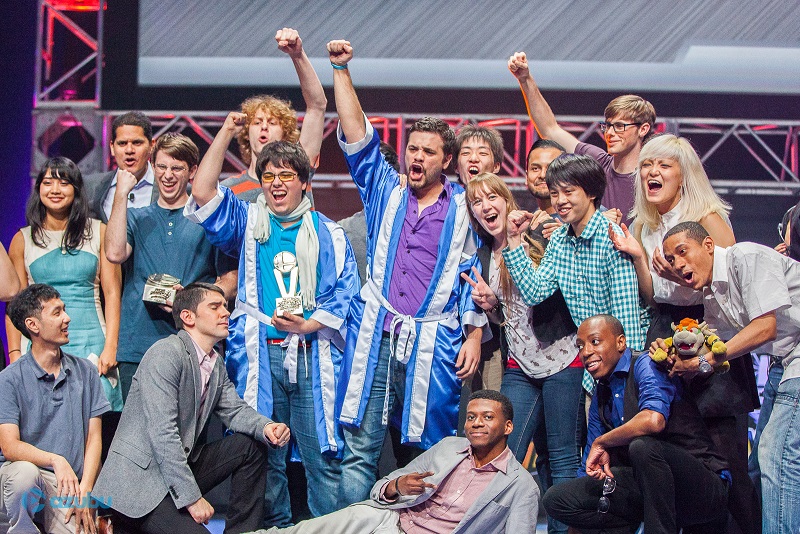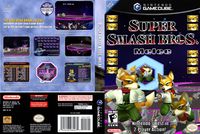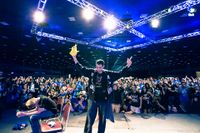The 'Shroom:Issue 100/A Look at Competitive Melee
As I’m starting to write this, the CEO gaming tournament has just wrapped up. I've just witnessed some incredible, high level play of Super Smash Bros. Melee and it was an all-around blast to watch. I’m sure many of you are familiar with the Super Smash Bros. series. How can you not be? It’s one of Nintendo’s best selling and most enjoyable franchises. If you own a Gamecube or a Wii, you likely own their respective Smash games. However, did you know there’s a whole different side of Smash you may have never even seen? In this article I’ll be shedding a little light on the crazy world of competitive Super Smash Bros. Melee.
Let’s rewind back to Autumn 2001. Nintendo releases its brand new console, the GameCube and shortly thereafter, Super Smash Bros. Melee, the sequel to the hit game on the Nintendo 64. The game was a big success and went on to be the best selling game on the system, even beating out major franchises like Mario Kart. This game did everything a good sequel should, it took a great concept and brought it to new levels. The new graphics, gameplay, and overall content were greatly expanded upon, but the gameplay is what I want to focus on right now. Smash 64 was pretty fast game in and of itself, but Melee’s pace was even faster. Characters moved faster, fell faster, and killed earlier. The game was hectic, but it always felt in your control. The flow and the way the characters moved just felt amazing.
Even as early as 2002, small grassroots tournaments were being established. Players were drawn to the intense gameplay and as people played, they found ways to push the game even further than how the developers had intended. It was discovered that air dodging into the stage at a diagonal angle would result in the character sliding forward a bit. This movement option became known as “wavedashing”. Other mechanics like Directional influence, L-canceling, dash dancing and several others were used to push the limits of the game and allow for never before seen combos and gameplay. I don’t want to talk too much about how these work, so if you want to know more about these techniques, our NIWA affiliate SmashWiki has detailed pages about all of them.
But I’m not here to read off advanced techniques like a textbook. What I want to talk about is the community surrounding competitive Smash, and why people love it so much. I guess I should first clear up a big misconception surrounding this community, specifically the whole “No items, Fox only, Final Destination” meme that I’m sure you’ve heard of. This is a very common misconception about how competitive Smash is played. Yes, items are turned off, but for good reason. They add in a factor of uncontrolled randomness that makes the game unbalanced. It’s the equivalent of placing landmines in a soccer field. Items do not have a place in a game where the winner is determined by skill, not raw luck. Items were on for a little bit in the competitive circuit, but were soon removed. Let’s just says no wants to lose thousands of dollars worth of potential prize money when a bob-omb happens to spawn right in front of you.
The “Fox only” myth is just outright wrong. Yes, Fox is considered to be the best character in Melee and is the highest on the tier list, however there are plenty of other characters that see a lot of high level play; Falco, Sheik, Marth, Jigglypuff, and Peach are all good examples. A recent instance of character diversity was at Paragon 2015, a tournament back in January, as without counting repeated characters, Top 8 saw a Jigglypuff, Samus, Peach, Pikachu, Falco, Fox, Marth, and Sheik. The Jigglypuff player, Hungrybox, actually won the whole thing. While many top players use Fox, there is certainly more character variety then you may think; one of my favorite examples is the Japanese player aMSa, who uses Yoshi, a character not considered to be that great. He managed to get 5th at Apex 2015, the largest Smash tournament until EVO 2015, which should be going on when this article is posted, and came down to the last stock of the last game against Mango, who is considered the best player in the world. It just goes to show you a low tier character can throw even the best players for a loop.
The last portion of the meme is the Final Destination segment. While FD is one of the six stages used in competitive Melee, it's nowhere near the most played or even most balanced. Competitive Smash uses only the most balanced and fair stages for tournament play, so this means stages with hazards, walk-offs, or other intrusive elements are not allowed in competitive play. A total of six stages are used. Five are considered “starter stages;” these are Battlefield, Final Destination, Yoshi's Story, Fountain of Dreams, and Dream Land. Since they are “starters,” they can be selected at the beginning of a set between two players. A system called stage striking is also used where players take turns banning stages they don’t want to play on until one is reached. For example, if I’m playing as Marth and fighting a Jigglypuff, I may ban Dream Land because the large stage size helps Jigglypuff live, as her air mobility lets her play keep away, and because the platform layout isn’t as great for Marth. In turn, the Puff player may ban Yoshi’s Story and Final Destination next because he knows Marth can perform well on those stages. I then may ban Fountain of Dreams, because Marth prefers smaller blastzones. We then end up going to Battlefield.
If I win the first game, the Puff player now has the choice of where to go. This is where the sixth stage comes in, Pokémon Stadium, which is considered a “counter-pick” because it can only be selected in this way. The reason for this is because it is not as neutral as the other five stages and heavily favors certain characters; for example, Fox players often like to go here. In this hypothetical scenario, the Puff player can choose to go to Stadium if he wants, but I would advise against that considering he’s playing a Marth, but I digress.
Now that I’ve gotten the big stereotype out of the and have disproved it, I want to talk about why I love this community. Smash had always been one of my favorite franchises, and when I discovered the competitive side, I was confused and a little turned off at first. It just seemed so different and complicated compared to what I was used to. My friends at school were starting to follow the scene and they convinced me to watch The Smash Brothers, a four hour documentary about the competitive Melee scene. To anyone out there who wants to learn about competitive Smash’s history or is even interested, give it a watch on EastPointPictures’ YouTube channel, although I cannot stress enough that it doesn’t cover everything, so don’t consider it the gospel. After I watched it though, I was hooked. Soon after, Apex 2014 rolled around. It was a great tournament to watch and was full of hype moments like Leffen getting 4-stocked, Mango winning a match while the crowd sang the national anthem behind him, aMSa showing everyone just how good Yoshi could be, and one of my favorite Smashers, PPMD, winning the whole thing. It was just incredible to watch. The high level play and technical prowess of the players is a sight to behold, and is one of the biggest draws to this community. The way the players react on the fly as well as carefully plan out combos and strategies is always a marvel, and I have a ton of respect for these people who have mastered this game. Even still, the metagame continues to advance and I wonder if anyone could ever truly master the game. That’s why I love it so much. It’s taking something designed to be a simple party game, and elevating it to new, incredible heights the developers never even imagined.
Another huge drive is the passion. These players devote their lives to this game that they love. You may love Smash Bros., but Mango said it best when describing his attachment to this game, saying “You don’t know what love is.” I don’t mean to discredit anyone’s love for this game, but these are truly some of the most passionate players to exist. Never before have I seen a group of people this involved in a game that’s fourteen-years old, and it's only getting bigger and more popular. On that subject though, I guess I should address the elephant in the room... What about the other Smash games? Let me just preface this by saying that this isn’t meant to harbor any ill will to the other games, but I have to be blunt. They just aren’t as suited for a competitive environment. Again, I love playing every Smash game, but there’s a reason Melee has a thriving tournament scene, as the gameplay and amount of competitive depth is just on a higher level. That’s not to say the other games don’t have potential; in fact, Smash 64 is an awesome game to watch for it’s awesome combos and high level play by people like Isai. I feel like if it had more exposure, it could truly become something great, but it just doesn't have enough attention directed towards it sadly.
As for Brawl and Smash 4, it’s a different story. I totally respect players of both these games, but for me personally, they just aren’t as enjoyable to watch at a high level. Both games are slower paced, floatier, and seem to intentionally be made to be distanced from high level play. Several advanced techniques were removed because in Sakurai’s mind, they were somehow “unfair”. Brawl also has problems in the form of random tripping and a meta game heavily centered around Meta Knight, as well as all the strong grab options involving the Ice Climbers. Once again, that’s not to say this game doesn’t have great players; people like ZeRo, Mew2King, and others have shown how skilled they can be at this game. Smash 4 fixes a lot of the issues with Brawl by removing random tripping, balancing characters far more efficiently, as well as making the game much more appealing to look at in its art style. It also improved the speed of the game, but it still is very defensive and slow. However, Smash 4 has a large community surrounding it, especially with Nintendo’s recent support for competitive Smash, and the game is scheduled to be at EVO this year and has a ton of entrants. I wish only the best towards the Smash 4 competitive scene.
I know some people may see the attachment to Melee as nostalgia and clinging to the past, but for many people, the later games just don’t have that same appeal that Melee has. I know Sakurai personally isn’t that fond of the scene, but it really is too bad; we may not play the game the same way he envisions, but there’s nothing wrong with that. I can understand why he likes the more casual style of play, but it really is no excuse for intentionally designing Brawl to dismiss competitive play. A group of people who were dissatisfied with all these changes made a mod for Brawl called Project M, which takes Brawl and alters the gameplay back to Melee’s physics. It’s a truly awesome mod that balances all the characters, adds in new ones like Mewtwo and Roy, gives the characters new alternate skins like Dry Bowser and Ocarina of Time Link, and brings back a ton of retro stages. I highly recommend checking out their website to learn more.
The topic of competitive Smash is not something I can easily sum up in an article, as it's a massive community with fourteen years of history behind it, and hopefully many more to come. As I said, The Smash Brothers documentary is a great starting point to learn about why this is such a big deal to so many people, and the internet is also full of great communities like SmashBoards where you can talk in great length about anything Smash; everything from discussing advanced Fox techniques to why King K. Rool should be a Smash 4 DLC character (#krocthevote). Watching high level matches is also a great way to learn. When this is posted, it will be day 2 of the gigantic EVO gaming tournament. Tune in on Sunday to see the finals for Melee; their website has all the details about times. Even if you can’t watch it live, matches will be uploaded online. Finally, for anyone who really wants to become a competitive player, go to local events, or even start a Smash club at school. No matter where you are, there’s likely at least a small group of people who love to play Smash at this advanced level. I hope I made this subject interesting and was able to teach people a little about this completely different, but equally fun, side of Super Smash Bros.


